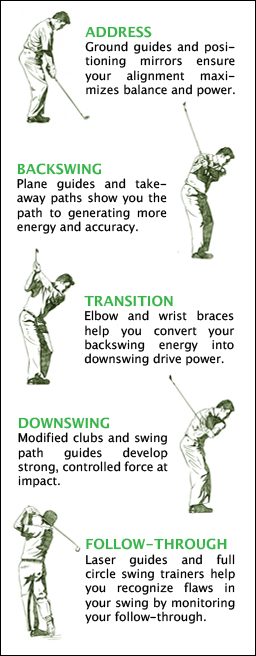|
www.GolfTrainingAid&TeachingTool.com Golf Teaching Aid A golf teaching aid can greatly improve your swing. No matter what phase of your swing gives you trouble, there is a golf teaching aid designed to help. Your swing will only be as good as its worst part. To improve your whole swing, you will need to focus on one phase and one golf teaching aid at a time. This article will help you select the correct golf teaching aid for each phase of your swing -- whether it's your address, backswing, transition, downswing or follow-through. It's up to you to decide which part of your swing to work on.
Transition: The transition phase of your swing converts the energy produced during your backswing into the driving power of your downswing. A golf teaching aid for your transition should help you align your arms in such a way that your club can follow the path of least resistance, maximizing the returns from your stored force. One type of device that can teach you correct arm alignment is a brace. Braces for elbows and wrists are commonly used to teach a good transition. The Swing Extender, for example, attaches to your right bicep -- for right-handed golfers --, preventing your back arm from over-collapsing (swingextender.com). Anther bracing device is the Right Angle 2, which fits around your back forearm and upper arm. It prevents your arm from folding more than 90 degrees, correctly positioning it for a powerful downswing (intheholegolf.com). Downswing: During the downswing, you utilize all your body's stored energy to create maximum, controlled force at impact with the ball. Correct club path and tempo are essential for distance and accuracy. A golf teaching aid for your downswing should work on swing path, swing plane and tempo. Modified clubs -- both hinged and flexible -- and swing path guides can be useful. For example, Whippy TempoMaster Clubs have flexible shafts that allow you to feel what you are doing wrong in your swing and eliminate an over the top swing (tempomaster.com). A swing path guide, such as the Inside Approach, can help you develop the proper swing path through the impact zone, which enables you to hit powerful, accurate shots (info.insideapproach.com). Follow-through: Although the follow-through doesn't affect the flight of your ball, it is useful in recognizing flaws in your swing. A proper follow-through travels along the same path as your downswing. Any deviation from that plane, wobble in your balance or breaking of the arms and wrists is a sign that something in your swing is off. A golf teaching aid for your follow-through should help you recognize signs of a swing error. Laser guides are useful in monitoring the plane of your follow-through. For example, Plane Sight is a laser light that attaches to the butt of your club. By monitoring the image projected on the ground during your follow-through, you can tell if your swing is vertical, flat or on plane (planesight.com). Full circle swing trainers -- circular frames that define you swing plane -- can also aid your follow-though. The Super Swing Trainer, for example, is an adjustable PVC frame that guides your swing and follow-through along the optimal plane. If your follow-through is off, you will hit the frame, alerting you to the error (superswingtrainer.com). Each phase of your golf swing must be done correctly to hit the ball well. If you need help in a particular area, there is a golf teaching aid available that can help fix your swing. Your job will be to determine which area needs the most help. Additional Information: If you were unable to find the right teaching aid for you, read our related article Golf Training Aid, which is a comprehensive guide for golf teaching aids. You can also look at our related article Golf Teaching Tool, which tells you which training aids correspond with each part of your body, including your wrists, elbows, posture, legs and feet. For a more in depth look at Golf Impact Indicators read our article Golf Impact Indicator to find which type will work best for you. © Copyright 2006 www.GolfTrainingAid&TeachingTool.com |
